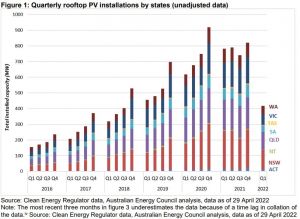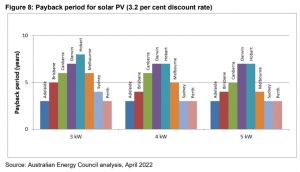Rooftop solar installation numbers have plummeted during the first quarter of 2022 as rising costs continue to plague the industry.
The Australian Energy Council’s (AEC) latest quarterly report revealed solar uptake hit its lowest in almost three years, with only 417 megawatts (MW) installed in January to March this year.
While more than 52,000 new solar systems were installed during this period, it barely scraped half of what was seen in the previous quarter.

Household hesitancy appears to be driving the drop in solar uptake, with increases to both installation and general living costs potentially impacting consumer decisions.
According to the AEC, households are typically paying almost $1,000 more to install a system of the same size and capabilities in 2022 than that seen the year prior.
A reduction in small-scale technology certificates (STCs) – used to help offset the cost of solar installations – as well as wet weather conditions in Queensland and New South Wales earlier this year may have also played a part in declining installation numbers.
While this is the first instance of uptake slowing, industry experts have been anticipating a decrease in solar installations as supply chains and the cost of transporting materials and polysilicon (used to make solar cells) were impacted by the pandemic.
Despite enduring inclement weather, however, NSW remained the frontrunner for solar installations in the country, recording more than 15,200 new installations during the first quarter of 2022.
Advertisement
Which states are paying the most to install solar?
Solar installation prices managed to stay relatively stable for most states in January to March this year, according to the AEC. However, in NSW, the cost of a three-kilowatt (kW) system had increased by $400 from January to March, while a 5kW system jumped $280.
Hobart and Darwin continue to see the highest prices for solar installations nationally. Households in these cities are currently looking at more than seven years to payback their solar system.
The AEC also noted bill-payers in Perth, Adelaide and Sydney are likely to have the quickest payback times for their solar system, while Melbournians could shave their payback time by two years if they installed a 5kW system instead of a 3kW system.

A recent Canstar Blue survey revealed that Aussie households are paying $5,520 on average for a solar installation. Over one-fifth of survey respondents stated they installed a 5kW system, while almost one-sixth installed a system bigger than 6kW.
Want to maximise your solar savings? Check out these energy plans
Below we have listed some of the cheapest solar-specific energy plans on our database. These deals are generally marketed towards customers with solar panels, but as always, be sure to check the fine print before signing up.
Here are some of the cheapest solar-specific deals from the retailers on our database. These costs are based on the Ausgrid network in Sydney but prices will vary depending on your circumstances. We show one product per retailer, listed in order of lowest price first. Annual price estimates assume general energy usage of 3900kWh/year for a residential customer on a single rate tariff. Price estimates exclude solar feed-in tariff credits. These are products from referral partners†. Our database may not cover all deals in your area, and please check retailer websites for up to date information.
Here are some of the cheapest solar-specific deals from the retailers on our database. These costs are based on the Citipower network in Melbourne but prices will vary depending on your circumstances. We show one product per retailer, listed in order of lowest price first. Annual price estimates assume general energy usage of 4000kWh/year for a residential customer on a single rate tariff. Price estimates exclude solar feed-in tariff credits. These are products from referral partners†. Our database may not cover all deals in your area, and please check retailer websites for up to date information.
Here are some of the cheapest solar-specific deals from the retailers on our database. These costs are based on the Energex network in Brisbane but prices will vary depending on your circumstances. We show one product per retailer, listed in order of lowest price first. Annual price estimates assume general energy usage of 4600kWh/year for a residential customer on a single rate tariff. Price estimates exclude solar feed-in tariff credits. These are products from referral partners†. Our database may not cover all deals in your area, and please check retailer websites for up to date information.
Here are some of the cheapest solar-specific deals from the retailers on our database. These costs are based on SA Power network in Adelaide but prices will vary depending on your circumstances. We show one product per retailer, listed in order of lowest price first. Annual price estimates assume general energy usage of 4000kWh/year for a residential customer on a single rate tariff. Price estimates exclude solar feed-in tariff credits. These are products from referral partners†. Our database may not cover all deals in your area, and please check retailer websites for up to date information.
What about solar battery uptake in Australia?
The AEC found the uptake of solar batteries in Australia remained steady. South Australia and New South Wales currently lead the way in terms of installing a solar storage unit alongside a panel system, bringing in 25 and 23 per cent of sales, respectively.
Queensland had the slowest uptake of solar batteries, accounting for just 11.8 per cent of the total solar-with-battery installations in the country.

Image credit: Roy Pedersen/Shutterstock.com, Australian Energy Council.


Share this article